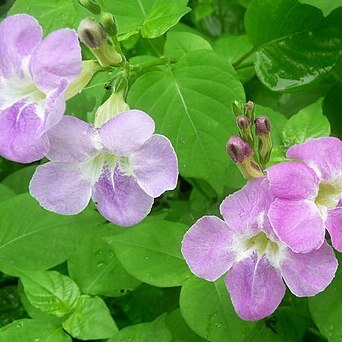Herbs or subshrubs, with cystoliths. Leaves petiolate; leaf blade margin entire to crenate. Inflorescences terminal or axillary, unilateral spikes or racemes, or panicles of these; bracts small, shorter than calyx; bracteoles similar to bracts or sometimes absent. Calyx 5-lobed; lobes equal to subequal. Corolla funnel-shaped; tube expanded distally into a throat; limb ± 2-lipped, often appearing subactinomorphic with 5 ± equal lobes; lobes ascending cochlear in bud. Stamens 4, included in or partially exserted from corolla tube; anthers 2-thecous; thecae parallel to sagittate to subperpendicular, equally to unequally inserted, base muticous or with a small basal appendage; staminodes 0. Ovary with 2 ovules per locule; stigma capitate, 2-lobed or 2-dentate. Capsule with a solid stalk at base, clavate, up to 4-seeded; retinacula present. Seeds lenticular, lacking trichomes.
Herbs or shrubs. Leaves with abundant cystoliths above when mature, entire, petiolate. Inflorescences of secund spikes or racemes, these loose or compact, simple or branched. Flowers solitary on short pedicels, subtended by 2 small bracts and 2 bractlets of about equal size; calyx 5-merous, the segments linear or lanceolate; corolla white, blue, purple, rose or yellow, the tube short to funnel-form, the lobes subequal; stamens 4, didynamous, the anthers oblong with 2 parallel cells, sometimes spurred at the base; ovary 4-ovulate, pubescent; the stigma minutely 2-parted or subcapitate. Capsule elliptic, 2-4-seeded; seeds compressed, orbicular or irregularly angled, glabrous.

